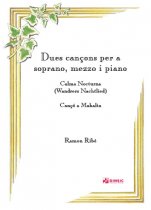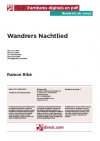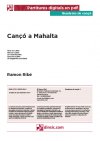Dues cançons per a soprano, mezzo i piano
Author/Composer
Translator
Text
Field
Collection
Quaderns de cançó (publicació en paper) Nr. 4
Language
Spanish, Catalan, English, Music
Format
Score
Contents
The Wanderer’s Nightsong
The Wanderer’s Nightsong, in many people’s view the most perfect lyric in the German language, was written by Johann Wolfgang von Goethe in 1776. Over eighty composers have set the poem to music in the last two centuries, either for solo or for choir singing. Among the best known of them, Franz Liszt, Max Reger, Franz Schubert, Robert Schumann, Charles Ives and Wilhelm Kempf.
It might seem presumptous for another musician to set it to music once more, says Ramon Ribé. He had, however, a good reason to do so. Joan Bofill Soliguer, a close friend, great pianist and musicologist, had given him a translation of the poem into Catalan, done in 1974 during the years of his study leave in Munich. It was a superb translation, singable, and a temptation for Ramon. As he says, “poetry resonates differently in each of us and, while reading Joan’s translation, I was already hearing sounds in my head.”
Song to Mahalta (2011)
“We will never be able to overcome these mountains (...) We cannot aspire to live in the world, Mercè. We have to seclude ourselves to this little valley. Let us make it –our valley, beautiful. Let us carve each of its stones with our hands and our love [...] (Màrius Torres, Letter to Mercè Figueres).
During his long stay in the tuberculosis sanatorium of Puig d’Olena (in Sant Quirze Safaja), Màrius Torres, the great Lleida poet, met Mercè Figueres, a young lady from Girona, who was also being treated there. She became his most intimate friend and the person who was to inspire the whole series of his Songs to Mahalta. “Mahalta”, a woman’s name used by the nobility in the Middle Ages, says much of his love and the status his friend had in his eyes. A medical doctor himself, Màrius spent most of his time in the sanatorium reading philosophy, playing piano and writing poetry. He died at thirty-two in 1942.
This song is dedicated by Ramon Ribé to his brother Joan -a memory of old stories and of wild dreams shared in their childhood at a time when their imagination burned with images of adventure and of non-existant worlds.
Structure
Technical Specifications
Measurements
21 x 29,7 cm, vertical
Binding
Staple. Matt plastic-coated cover.
Number of Pages
30
ISMN
979-0-69210-817-7
Editor
DINSIC Publicacions Musicals
Also collaborating:
Cover Designer
Hélène Giraudier












